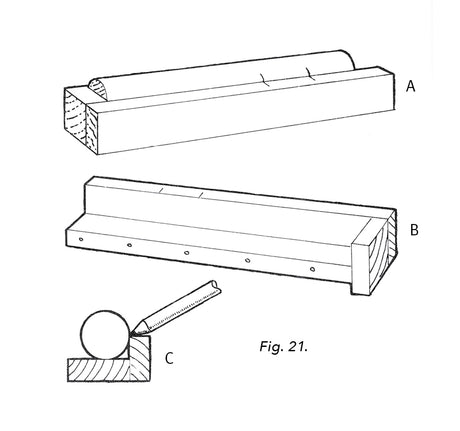Notice: This item is currently only available for In-Store pick-up. If it is in your cart and you choose delivery at checkout, you will be unable to check-out. Thank you for your understanding and patience!
Lost Art Press
The Solution at Hand
The Solution at Hand
SKU: LAP-SolutionAtHand-HB
Couldn't load pickup availability
This item is currently only available for In-Store Pickup
You can download an excerpt of this book here.
By Robert Wearing
Becoming proficient at handwork isn’t just about muscle memory and learning to sharpen. It’s also about building a handful of effective “appliances” (jigs, fixtures and the like) that assist your saws, planes and chisels for repeatable work.
One of the foremost experts on these appliances is Robert Wearing, who wrote extensively about them for Woodworker magazine and published a number of books on the topic. Earlier this year we approached Wearing about collecting the best of the appliances for handwork into one new book, and he agreed.
The result is “The Solution at Hand: Jigs & Fixtures to Make Benchwork Easier,” a hardbound book of our favorite jigs from Wearing’s career. The book covers a wide swath of material, from building workbench appliances for planing, to making handscrews (and many other ingenious clamps), some simple tools that you cannot buy anywhere else, to marking devices that make complex tasks easier.
In all, there are 157 jigs, all of which are illustrated with Wearing’s handmade drawings. The book is designed as more of a reference book than something you read straight through. Already after editing the book, I now find myself returning to it and thinking: I know Wearing had a solution for this problem. And he did.
“The Solution at Hand” is 200 pages long and is in a 6” x 9” format (like Wearing's “The Essential Woodworker”). The pages are casebound, sewn for long-term durability and wrapped in hardback boards that are covered in cotton cloth. As always, our books are produced and printed entirely in the USA.

About the Author
Acclaimed craftsman and woodworking instructor Robert Wearing was formally trained at Loughborough College (now University) in Leicestershire, England. It was there, during the late 1940s, that a physical education teacher said a sentence that Wearing has embraced throughout his long and fulfilling career: “For teacher and pupil, a lesson should be an enjoyable, purposeful activity.”
For Wearing, his childhood lessons in the building of things came from his father, a sailor, and a model construction kit.
Both sides of Robert Wearing’s family came from the south of the United Kingdom’s Lake district. “After WWI my parents married there, but jobs for young officers were hard to find,” Wearing says. “So my father, like the rest of his family went to sea.”
Wearing’s father sailed in Atlantic liners, first to New York and then later to Rio de Janeiro, a six-week voyage. Between trips his father would spend two weeks restocking for the next voyage. The family moved into a house vacated by a family member in the port of Liverpool. This way, when Wearing’s father was on land, he could take the tram home each night to be with the family.
“He was not a craftsman,” Wearing says. “I would call him a useful handyman with tools bought in New York.” Wearing’s father enjoyed building models and mechanical devices with “Meccano,” a model construction system created in their hometown of Liverpool by Frank Hornby. Wearing’s father taught his son how to solder. And while at sea, Wearing’s father would compile lists of parts to convert. “I think I owe a great deal to Meccano, which taught me the basic principles of design,” Wearing says.
Read more about Robert Wearing in this full profile.
Share




















